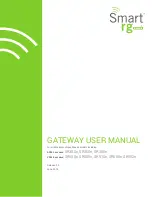
6381-A4 Router Users Guide
37
VPI
Virtual path identifier, equivalent to the virtual path connection (VPC).
VCI
Virtual channel identifier. A 16-bit field in the header of an ATM cell. The VCI,
together with the VPI, is used to identify the next destination of a cell as it passes
through to the ATM switch.
QoS
Quality of service, a characteristic of data transmission that measures how
accurately and how quickly a message or data is transferred from a source host to
a destination host over a network. The three QoS options are:
•
Undefined Bit Rate (
UBR
): When UBR is selected, the PCR, SCR, and
MBS fields are disabled.
•
Constant Bit Rate (
CBR
): When CBR is selected, the PCR field is
enabled.
•
Variable Bit Rate (
VBR
): When VBR is selected, the PCR, SCR, and MBS
fields are enabled.
More on QoS is covered in Quality of Service (QoS) on page 92.
PCR
Peak cell rate, measured in cells/sec, is the cell rate which the source may never
exceed.
SCR
Sustained cell rate, measured in cells/sec, is the average cell rate over the
duration of the connection.
MBS
Maximum burst size, a traffic parameter that specifies the maximum number of
cells that can be transmitted at the Peak Cell Rate.
Auto PVC
Auto-Sensing permanent virtual circuit. The overall operation of the auto-sensing
PVC feature relies on end-to-end OAM pings to defined PVCs. There are two
groups of PVCs: customer default PVCs which are defined by the OEM/ISP and
the backup PVCs. The customer default must have 0/35 as the first default PVC.
The backup list of PVCs must be of the following VPI/VCI: 0/35, 8/35, 0/43, 0/51,
0/59, 8/43, 8/51, and 8/59. The lists of PVCs are defined in XML and are
configurable. The Auto-Sensing PVC feature itself is also configurable in that the
auto-search mechanism can be disabled.
Upon DSL synchronization, end-to-end OAM pings will be conducted for each
defined PVC. The result of the pings will be recorded in an array for later use to
determine the usability of the particular PVC for connectivity. This list helps the
PVC manage the available PVC for use, and needs to be synchronized with
connections made without Auto-Sensing PVC. Update to this list is performed for
any change in DSL synchronization.
During connection establishment, the PVC module will first search through the list
of defined default PVCs. If a PVC is found from the default list that is ping-able
and not in use, the PVC module will update for that particular PVC as in-use from
the list and continues processing. If a PVC is not found in the default, the backup
PVC list is used. If no PVC is found again, the module will let the end-user know
that no available VCC was found.
With the connection established, the PVC is stored in flash as the connection
default PVC. Therefore upon reboot, this PVC is automatically chosen as the PVC
for that connection. This saved PVC in environment space of flash overrides the
PVC connection saved in XML configuration space of flash for that connection.
During the connection establishment processing, the saved PVC will be checked
to see whether a connection can be made with the PVC. If the PVC is OAM ping-
able, the connection process continues. If the PVC is not OAM ping-able, the
search for available PVC starts. The process of PVC selection is the same as
described above.
The list of default PVCs and backup PVCs need to be global for the management
of all connections, non Auto-Sensing PVC connection, as well as, Auto-Sensing
PVC connections. These lists allow the end-users to establish connectivity without
keeping track of the PVC used.
















































